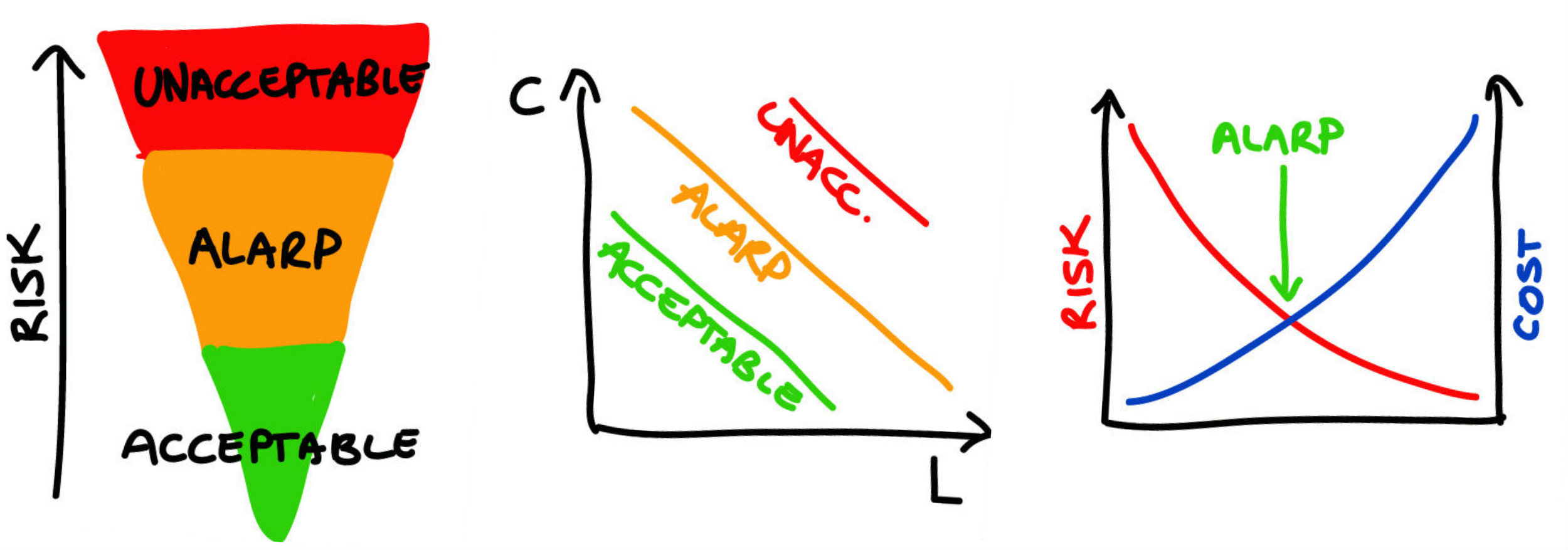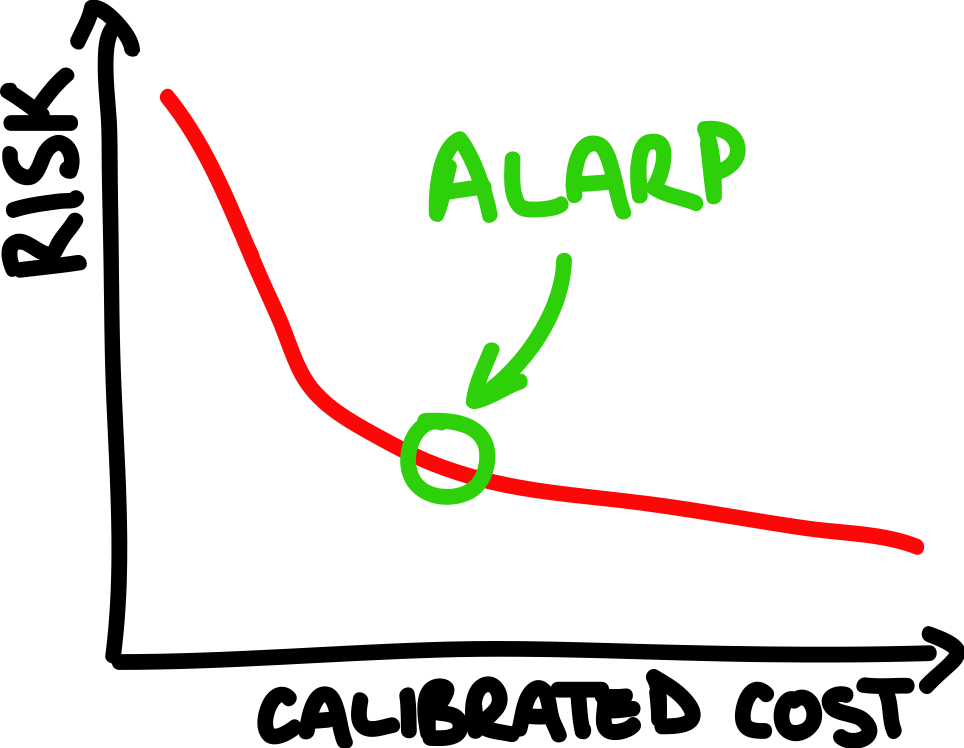As Low As Reasonably Practicable
It's another staple of the risk management diet but while I believe this one to be a completely valid concept, I can't help to feel that its being served up underdone. This time I'm talking about ALARP - As Low As Reasonably Practicable. To define ALARP, at least how I do, would probably negate the need to write the rest of this post. So let's just say that ALARP is the point at which any further reduction in risk would require resources significantly greater than the magnitude in the benefit gained*.
It is often described graphically. Here are a few examples of the types of diagrams you may see helping to explain the concept:
ALARP
The left diagram is the one I see the most although I am seeing, more and more, other representations including the other two. Rather than link any specific instances on the web, feel free to find such diagrams using Google Images.
So what are the problems that I see with most of these graphs? Thanks for asking...
The ALARP Region
In the left diagram, it is shown as an orange trapezoid and in the centre diagram, it is a line but in both cases the point of this area is to identify the level of risk acceptable if ALARP is achieved. Sometimes, the diagram is missing some commentary so it looks like that this region is simply the ALARP region - whatever that means.
Going hand in hand with the former definition though is that risks falling in the green area need not be treated at all and we'll come back to this.
Axes (as in plural of axis)
Often the nature of the axes is confusing. Take exhibit A (the one on the left), it has a y-axis but not x-axis. Sometimes you see risk magnitude shown as an x-axis but isn't risk level and risk magnitude the same thing?
Anyway, the diagram on the right has a bigger problem than that. It has no label on the x-axis but it does have two y-axes. The two plotted lines intersect at a point identified as the ALARP point.
But what is the significance of the intersect when different scales are used? I would argue that unless you identified the exact relationship between the two scales, there is no significance - not to ALARP or acceptability of the risk.
Two Questions
I see ALARP as not a question relating to acceptability - i.e. risk evaluation - but a question relating to risk treatment. Two different questions, but do both have to be answered?
If we follow the standard ISO 31000 RM process, the question of acceptability appears first and allows for the decision to not treat the risk, instead relying on existing controls. The standard does start to talk about cost-benefit considerations but stops short of requiring the achievement of ALARP at either the evaluation or treatment stages.
It appears to me that ALARP tends to be enshrined in regulations or case law. CASA aeronautical studies often include the following quote from an Australian High Court decision.
Where it is possible to guard against a foreseeable risk which, though perhaps not great, nevertheless cannot be called remote or fanciful, by adopting a means which involves little difficulty or expense, the failure to adopt such means will in general be negligent.
So, it seems that regardless of the inherent acceptability of a risk, it must still be treated to ALARP**. Meaning that you need to answer both questions separately.
Have I treated this risk to a level ALARP?
Is the residual level of risk acceptable?
My ALARP Diagram
In conceptualising my take on ALARP, I'm going to steal from the UK HSE department:
“‘Reasonably practicable’ is a narrower term than ‘physically possible’ … a computation must be made by the owner in which the quantum of risk is placed on one scale and the sacrifice involved in the measures necessary for averting the risk (whether in money, time or trouble) is placed in the other, and that, if it be shown that there is a gross disproportion between them – the risk being insignificant in relation to the sacrifice – the defendants discharge the onus on them.”
Those seem like some pretty clear directions. Risk on one axis and cost on the other. In order to make the slope of that line mean something, the cost scale needs to be calibrated to the risk scale but I have no idea how one would actually do this - maybe we'll tackle that one later. See below for a very rough, hand-drawn diagram. The ALARP point is rather hard to identify but it is the point where the slope of the line exceeds the cost-benefit limit.
Screen Shot 2012-04-20 at 10.55.09 PM
Too often, I think we incorrectly lump related concepts into the same bucket and this leads to a blurring of the objectives of the process. In this case, ALARP fell in with risk evaluation when, I think, it should have remained separate and contained in the risk treatment part of the RM process.
Those risk professionals out there who possess ninja-like RM skills, can certainly short-cut the process to achieve the desire outcome but us grasshoppers*** should probably keep these concepts separate to ensure we cover off all requirements.
* Adapted from ALARP's wikipedia page.
** What this means for the standard, I'm not sure. I honestly hadn't thought about the implications of this thought process until I typed it just now.
*** I think I just mixed up kung-fu and whatever martial art ninjas do - no emails or dark-clad assassins please.
Image credit: Sam Willis (via Pexels)


